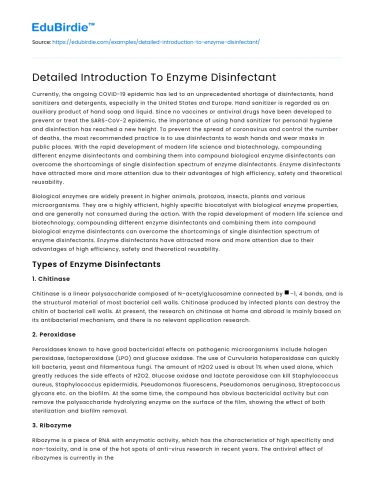Currently, the ongoing COVID-19 epidemic has led to an unprecedented shortage of disinfectants, hand sanitizers and detergents, especially in the United States and Europe. Hand sanitizer is regarded as an auxiliary product of hand soap and liquid. Since no vaccines or antiviral drugs have been developed to prevent or treat the SARS-CoV-2 epidemic, the importance of using hand sanitizer for personal hygiene and disinfection has reached a new height. To prevent the spread of coronavirus and control the number of deaths, the most recommended practice is to use disinfectants to wash hands and wear masks in public places. With the rapid development of modern life science and biotechnology, compounding different enzyme disinfectants and combining them into compound biological enzyme disinfectants can overcome the shortcomings of single disinfection spectrum of enzyme disinfectants. Enzyme disinfectants have attracted more and more attention due to their advantages of high efficiency, safety and theoretical reusability.
Biological enzymes are widely present in higher animals, protozoa, insects, plants and various microorganisms. They are a highly efficient, highly specific biocatalyst with biological enzyme properties, and are generally not consumed during the action. With the rapid development of modern life science and biotechnology, compounding different enzyme disinfectants and combining them into compound biological enzyme disinfectants can overcome the shortcomings of single disinfection spectrum of enzyme disinfectants. Enzyme disinfectants have attracted more and more attention due to their advantages of high efficiency, safety and theoretical reusability.
Save your time!
We can take care of your essay
- Proper editing and formatting
- Free revision, title page, and bibliography
- Flexible prices and money-back guarantee
Types of Enzyme Disinfectants
1. Chitinase
Chitinase is a linear polysaccharide composed of N–acetylglucosamine connected by β–1, 4 bonds, and is the structural material of most bacterial cell walls. Chitinase produced by infected plants can destroy the chitin of bacterial cell walls. At present, the research on chitinase at home and abroad is mainly based on its antibacterial mechanism, and there is no relevant application research.
2. Peroxidase
Peroxidases known to have good bactericidal effects on pathogenic microorganisms include halogen peroxidase, lactoperoxidase (LPO) and glucose oxidase. The use of Curvularia haloperoxidase can quickly kill bacteria, yeast and filamentous fungi. The amount of H2O2 used is about 1% when used alone, which greatly reduces the side effects of H2O2. Glucose oxidase and lactate peroxidase can kill Staphylococcus aureus, Staphylococcus epidermidis, Pseudomonas fluorescens, Pseudomonas aeruginosa, Streptococcus glycans etc. on the biofilm. At the same time, the compound has obvious bactericidal activity but can remove the polysaccharide hydrolyzing enzyme on the surface of the film, showing the effect of both sterilization and biofilm removal.
3. Ribozyme
Ribozyme is a piece of RNA with enzymatic activity, which has the characteristics of high specificity and non-toxicity, and is one of the hot spots of anti-virus research in recent years. The antiviral effect of ribozymes is currently in the experimental research stage. For example, Sarver applied ribozymes to the study of anti-HIV infection; Weizsaker studied the effect of tandem ribozymes on hepatitis B virus in vitro. The anti-viral treatment of ribozymes has revealed the dawn of hope, but there is no research on the application of ribozymes as disinfectants at home and abroad.
4. Bacteriophage lysins
Bacteriophage lysins are a class of proteins encoded by bacteriophages that are synthesized at the late stage of genome replication. They can hydrolyze peptidoglycans from bacterial cell walls to kill bacteria. Studies have shown that bacteriophage lyase has a good bactericidal effect on pathogenic bacteria such as Streptococcus pneumoniae, Bacillus anthracis, Lactobacillus, and Staphylococcus aureus. Bacteriophage lysins are still in the stage of laboratory research and clinical experiment.
5. Lysozyme
Lysozyme, also known as muramidase or N-acetylmuramidegycanohydrlase, is an alkaline enzyme that can hydrolyze mucopolysaccharides in pathogenic bacteria. It is widely present in various body tissues, egg whites of birds and poultry, tears of mammals, saliva, plasma, milk and other body fluids, of which egg white is the most abundant.
Lysozyme can effectively hydrolyze the peptidoglycan of bacterial cell wall, and its hydrolysis site is the β-1,4 glycosidic bond between the 1 carbon atoms of N-acetyl cell wall acid (NAM). Peptidoglycan is the main component of the bacterial cell wall, and the content of peptidoglycan in the cell wall of Gram-positive and Gram-negative bacteria is different. The cell wall of Gram-positive bacteria is almost entirely composed of peptidoglycan, while only the inner wall layer of Gram-negative bacteria is peptidoglycan. Therefore, lysozyme destroys the cell walls of Gram-positive bacteria more strongly than Gram-negative bacteria.
Lysozyme has strong heat resistance, the most suitable pH is 6.5, and it can be stable in acid medium. Iodine, imidazole and indole derivatives and surfactants have inhibitory effects on it. It will not be inactivated by the treatment of organic solvents. When transferred to an aqueous solution, the activity of lysozyme can be fully restored.






 Stuck on your essay?
Stuck on your essay?

